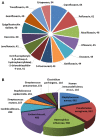MDAD: A Special Resource for Microbe-Drug Associations
- PMID: 30581775
- PMCID: PMC6292923
- DOI: 10.3389/fcimb.2018.00424
MDAD: A Special Resource for Microbe-Drug Associations
Abstract
The human-associated microbiota is diverse and complex. It takes an essential role in human health and behavior and is closely related to the occurrence and development of disease. Although the diversity and distribution of microbial communities have been widely studied, little is known about the function and dynamics of microbes in the human body or the complex mechanisms of interaction between them and drugs, which are important for drug discovery and design. A high-quality comprehensive microbe and drug association database will be extremely beneficial to explore the relationship between them. In this article, we developed the Microbe-Drug Association Database (MDAD), a collection of clinically or experimentally supported associations between microbes and drugs, collecting 5,055 entries that include 1,388 drugs and 180 microbes from multiple drug databases and related publications. Moreover, we provided detailed annotations for each record, including the molecular form of drugs or hyperlinks from DrugBank, microbe target information from Uniprot and the original reference links. We hope MDAD will be a useful resource for deeper understanding of microbe and drug interactions and will also be beneficial to drug design, disease therapy and human health.
Keywords: database; drug; drug discovery; drug target; microbe.
Figures





Similar articles
-
Microbe-Disease Association Prediction Using RGCN Through Microbe-Drug-Disease Network.IEEE/ACM Trans Comput Biol Bioinform. 2023 Nov-Dec;20(6):3353-3362. doi: 10.1109/TCBB.2023.3247035. Epub 2023 Dec 25. IEEE/ACM Trans Comput Biol Bioinform. 2023. PMID: 37027603
-
A novel approach based on KATZ measure to predict associations of human microbiota with non-infectious diseases.Bioinformatics. 2017 Mar 1;33(5):733-739. doi: 10.1093/bioinformatics/btw715. Bioinformatics. 2017. PMID: 28025197
-
Microbial Hub Taxa Link Host and Abiotic Factors to Plant Microbiome Variation.PLoS Biol. 2016 Jan 20;14(1):e1002352. doi: 10.1371/journal.pbio.1002352. eCollection 2016 Jan. PLoS Biol. 2016. PMID: 26788878 Free PMC article.
-
The Age of Next-Generation Therapeutic-Microbe Discovery: Exploiting Microbe-Microbe and Host-Microbe Interactions for Disease Prevention.Infect Immun. 2022 May 19;90(5):e0058921. doi: 10.1128/iai.00589-21. Epub 2022 Apr 6. Infect Immun. 2022. PMID: 35384688 Free PMC article. Review.
-
Gut microbes: from bugs to drugs.Am J Gastroenterol. 2010 Feb;105(2):275-9. doi: 10.1038/ajg.2009.729. Epub 2010 Jan 12. Am J Gastroenterol. 2010. PMID: 20068561 Review.
Cited by
-
GACNNMDA: a computational model for predicting potential human microbe-drug associations based on graph attention network and CNN-based classifier.BMC Bioinformatics. 2023 Feb 2;24(1):35. doi: 10.1186/s12859-023-05158-7. BMC Bioinformatics. 2023. PMID: 36732704 Free PMC article.
-
MagMD: Database summarizing the metabolic action of gut microbiota to drugs.Comput Struct Biotechnol J. 2022 Nov 12;20:6427-6430. doi: 10.1016/j.csbj.2022.11.021. eCollection 2022. Comput Struct Biotechnol J. 2022. PMID: 36467581 Free PMC article.
-
Discovery of a Secalonic Acid Derivative from Aspergillus aculeatus, an Endophyte of Rosa damascena Mill., Triggers Apoptosis in MDA-MB-231 Triple Negative Breast Cancer Cells.ACS Omega. 2020 Sep 18;5(38):24296-24310. doi: 10.1021/acsomega.0c02505. eCollection 2020 Sep 29. ACS Omega. 2020. PMID: 33015446 Free PMC article.
-
Identification of the key differentially expressed genes and pathways involved in neutrophilia.Innate Immun. 2020 May;26(4):270-284. doi: 10.1177/1753425919887411. Epub 2019 Nov 15. Innate Immun. 2020. PMID: 31726910 Free PMC article.
-
LCASPMDA: a computational model for predicting potential microbe-drug associations based on learnable graph convolutional attention networks and self-paced iterative sampling ensemble.Front Microbiol. 2024 May 23;15:1366272. doi: 10.3389/fmicb.2024.1366272. eCollection 2024. Front Microbiol. 2024. PMID: 38846568 Free PMC article.
References
Publication types
MeSH terms
LinkOut - more resources
Full Text Sources

